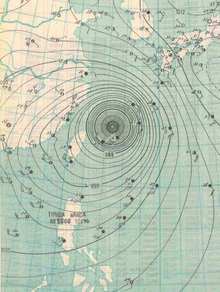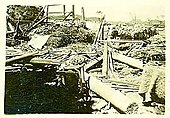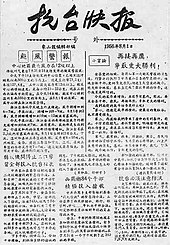| Revision as of 12:07, 9 August 2014 editHERB (talk | contribs)Autopatrolled, Extended confirmed users7,322 edits ←Redirected page to 1950–59 Pacific typhoon seasons#1956 Pacific typhoon season | Latest revision as of 16:33, 8 May 2024 edit undoJCMLuis (talk | contribs)Extended confirmed users, IP block exemptions12,393 edits →top | ||
| (42 intermediate revisions by 23 users not shown) | |||
| Line 1: | Line 1: | ||
| {{short description|Pacific typhoon in 1956}} | |||
| {{Use mdy dates|date=August 2020}} | |||
| {{Expand Chinese|topic=hist|date=August 2020}} | |||
| {{infobox weather event | |||
| | name = Typhoon Wanda | |||
| | image = 1,August,1956 Typhoon weather map.png | |||
| | caption = | |||
| | formed = July 25, 1956 | |||
| | dissipated = August 5, 1956 | |||
| }}{{infobox weather event/JMA | |||
| | winds = | |||
| | pressure = 915 | |||
| }}{{infobox weather event/JTWC | |||
| | winds = 160 | |||
| | pressure = | |||
| | basin = wpac | |||
| }}{{infobox weather event/Effects | |||
| | year = 1956 | |||
| | fatalities = 4,935 | |||
| | damage = | |||
| | areas = ] and ] | |||
| | refs = | |||
| }}{{infobox weather event/Footer | |||
| | season = ] | |||
| }} | |||
| '''Typhoon Wanda''' was one of the deadliest typhoons to impact ], and was the strongest typhoon to impact ] since ] in ]. | |||
| == Meteorological history == | |||
| {{storm path|Wanda_1956_track.png}} | |||
| A tropical depression developed southwest of Guam on July 25. It moved north-northeastward, passing east of the Northern Marianas. On July 27, it intensified into a tropical storm and was designated ''Wanda''. On the same day, the storm turned more westward, steered by the subtropical ridge to the north. Low wind shear and warm waters allowed Wanda to intensify steadily, developing into an intense typhoon. On July 30, reconnaissance aircraft recorded a minimum pressure of {{convert|902|mbar|inHg|abbr=on}}, and the peak winds were estimated at {{convert|295|km/h|mph|round=5|abbr=on}}. After passing through the ], Wanda weakened slightly and traversed the East China Sea. On August 1, the typhoon made landfall in eastern China near ], Zhejiang, producing a pressure of {{convert|923|mbar|inHg|abbr=on}}; this was the lowest pressure recorded in China from a tropical cyclone. Wanda slowly weakened while progressing through China, dissipating on August 5.<ref name="jma">{{cite web|author=Japan Meteorological Agency|date=June 1, 1989|title=RSMC Best Track Data – 1951–1959|url=http://www.jma.go.jp/jma/jma-eng/jma-center/rsmc-hp-pub-eg/Besttracks/bst5159.txt|url-status=dead|archive-url=https://web.archive.org/web/20120322110127/http://www.jma.go.jp/jma/jma-eng/jma-center/rsmc-hp-pub-eg/Besttracks/bst5159.txt|archive-date=March 22, 2012|accessdate=December 21, 2016|format=TXT}}</ref><ref name="Shi">{{cite book|url=https://books.google.com/books?id=AgI1DAAAQBAJ&dq=1956+%22typhoon+wanda%22&pg=PA123|title=Natural Disasters in China|publisher=Nature|year=2016|editor=Peijun Shi|pages=123–126|isbn=9783662502709}}</ref> | |||
| == Impact == | |||
| ] on Taiwan recorded {{convert|297.3|mm|in|abbr=on}} of rainfall over three days while the typhoon would pass to the north. Along the coast of Zhejiang, Wanda produced a {{convert|5.02|m|ft|abbr=on}} storm surge that destroyed 465 seawalls and 902 boats. The storm also flooded crop fields, destroying 20,380 tons of wheat. Across Zhejiang, 2.2 million houses and 38.5% of the main roads were damaged during the storm. Nationwide, Wanda killed 4,935 people and injured 16,617 others.<ref name="Shi" /> | |||
| {|style="margin: 0 auto;" | |||
| |+ '''Effects of Typhoon Wanda''' | |||
| | ] | |||
| | ] | |||
| | ] personnel carry relief supplies onto a plane after the typhoon]] | |||
| | ] | |||
| | ] when Wanda made landfall]] | |||
| |} | |||
| == See also == | |||
| * ] | |||
| == References == | |||
| {{Reflist}} | |||
| == External links == | |||
| * – ] | |||
| {{DEFAULTSORT:Wanda (1956)}} | |||
| ] | |||
| ] | |||
| ] | |||
| {{China-hist-stub}} | |||
Latest revision as of 16:33, 8 May 2024
Pacific typhoon in 1956
You can help expand this article with text translated from the corresponding article in Chinese. (August 2020) Click for important translation instructions.
|
 | |
| Meteorological history | |
|---|---|
| Formed | July 25, 1956 |
| Dissipated | August 5, 1956 |
| Unknown-strength storm | |
| 10-minute sustained (JMA) | |
| Lowest pressure | 915 hPa (mbar); 27.02 inHg |
| Category 5-equivalent super typhoon | |
| 1-minute sustained (SSHWS/JTWC) | |
| Highest winds | 295 km/h (185 mph) |
| Overall effects | |
| Fatalities | 4,935 |
| Areas affected | Taiwan and China |
| IBTrACS | |
Part of the 1956 Pacific typhoon season | |
Typhoon Wanda was one of the deadliest typhoons to impact China, and was the strongest typhoon to impact Zhejiang since Typhoon Nina in 1953.
Meteorological history

Map key Saffir–Simpson scale Tropical depression (≤38 mph, ≤62 km/h)
Tropical storm (39–73 mph, 63–118 km/h)
Category 1 (74–95 mph, 119–153 km/h)
Category 2 (96–110 mph, 154–177 km/h)
Category 3 (111–129 mph, 178–208 km/h)
Category 4 (130–156 mph, 209–251 km/h)
Category 5 (≥157 mph, ≥252 km/h)
Unknown Storm type
 Tropical cyclone
Tropical cyclone  Subtropical cyclone
Subtropical cyclone  Extratropical cyclone, remnant low, tropical disturbance, or monsoon depression
Extratropical cyclone, remnant low, tropical disturbance, or monsoon depression A tropical depression developed southwest of Guam on July 25. It moved north-northeastward, passing east of the Northern Marianas. On July 27, it intensified into a tropical storm and was designated Wanda. On the same day, the storm turned more westward, steered by the subtropical ridge to the north. Low wind shear and warm waters allowed Wanda to intensify steadily, developing into an intense typhoon. On July 30, reconnaissance aircraft recorded a minimum pressure of 902 mbar (26.6 inHg), and the peak winds were estimated at 295 km/h (185 mph). After passing through the Miyako Islands, Wanda weakened slightly and traversed the East China Sea. On August 1, the typhoon made landfall in eastern China near Zhoushan, Zhejiang, producing a pressure of 923 mbar (27.3 inHg); this was the lowest pressure recorded in China from a tropical cyclone. Wanda slowly weakened while progressing through China, dissipating on August 5.
Impact
Taipei on Taiwan recorded 297.3 mm (11.70 in) of rainfall over three days while the typhoon would pass to the north. Along the coast of Zhejiang, Wanda produced a 5.02 m (16.5 ft) storm surge that destroyed 465 seawalls and 902 boats. The storm also flooded crop fields, destroying 20,380 tons of wheat. Across Zhejiang, 2.2 million houses and 38.5% of the main roads were damaged during the storm. Nationwide, Wanda killed 4,935 people and injured 16,617 others.
 |
 |
 |
 |
 |
See also
References
- Japan Meteorological Agency (June 1, 1989). "RSMC Best Track Data – 1951–1959". Archived from the original (TXT) on March 22, 2012. Retrieved December 21, 2016.
- ^ Peijun Shi, ed. (2016). Natural Disasters in China. Nature. pp. 123–126. ISBN 9783662502709.
External links
This article related to the history of China is a stub. You can help Misplaced Pages by expanding it. |